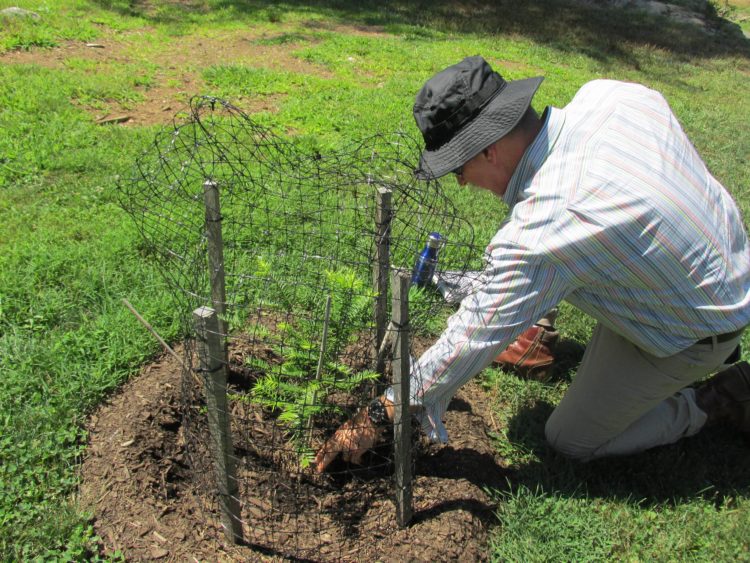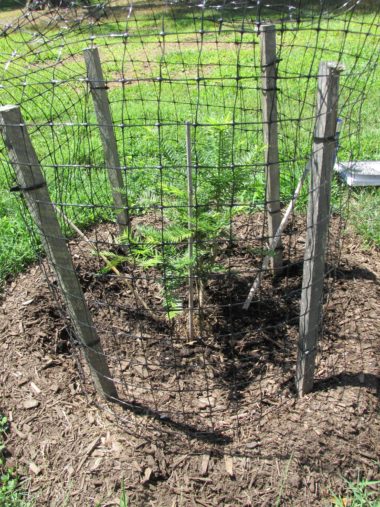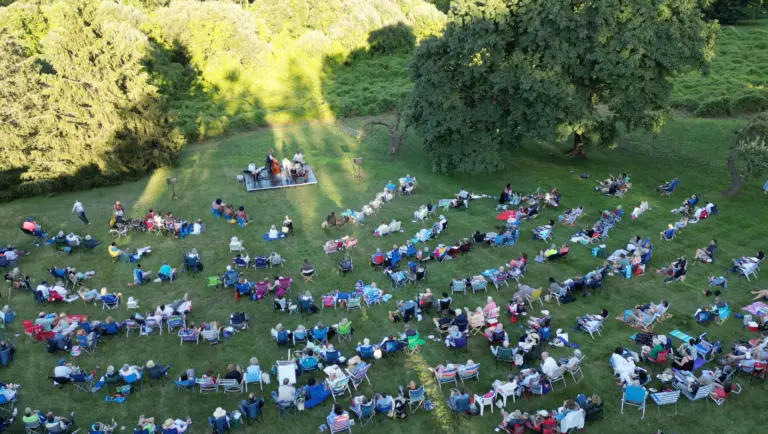
By Anne W. Semmes
The late and great biologist E.O. Wilson, whose dying effort was to save half the earth would surely be pleased to know of our Tree Warden Greg Kramer’s efforts to save one of the world’s oldest and most endangered conifers, the Torreya taxifolia. Unfortunately known as the Stinking Cedar Tree for its pungent odor when cut or bruised, there are now three of them planted in the Montgomery Pinetum.
Greg had the pleasure of meeting E.O. Wilson [who was my dear friend] some five years ago at a three-day symposium held on the critically endangered Stinking Cedar Tree at the Torreya State Park in northwest Florida. Wilson was the guest of honor amongst scientists working to save the species. “Having to stroll through the forest and talk all things with E.O. is a memory I cherish,” Greg has shared.
That Greg was able to secure three Stinking Cedar Tree seeds first from the Atlanta Botanic Garden overseeing conservation efforts for this species, that were then propagated at Florida’s Bok Tower Gardens where Greg has worked was rare in itself. And he was happy to show me how they are thriving. You’ll find two of them just right of the Monoliths, and one to the left overlooking the Reflection Pond. They are fenced in from the deer and are a lovely green color.
Planted as of May of 2021, they arrived a foot high and have now more than doubled their height, look swell, and smell nicely. “This year was very dry and sunny, and they did well,” shares Greg. “They’re quite hardy. Even though they’re native to Florida, they prefer cooler weather.” Fortunately, too, that deadly stem disease or fungus doesn’t survive further north, he tells.
“So, the tree itself is not in risk of extinction. It just needs to be planted out of its native range…It’s a pretty resilient tree. When it was a common component of the forest in the Apalachicola region of Florida, it was a quite common understory tree.”
How tall does it grow? “Twenty to 30 feet at most. And the wood is very dense. It was highly sought after by early pioneers until the fungus came in and brought the population down. So, it was a combination of over harvesting, the introduction of the fungus, and then just the normal deer browse.”
Greg is hoping there is a male and a female amongst these three trees but must wait “probably another five years” until the trees start producing their reproductive parts – “in this case because it’s a conifer it would be cones or if it has just pollen sacs. So, the hope is we can start to crossbreed the population. Because this population here are not related. They’re from different trees in different locations.”

So, Greg explains the three trees here were specifically determined by the Atlanta Botanic Garden as the “best fit for our collection. And when they do reach a reproductive stage, we’re not allowed to share the seeds with anybody. We have to get permission from Atlanta in order to do so. And they would then probably collect the seeds themselves and then distribute them to whoever requested.”
Greg also has Pinetum founder Colonel Robert Montgomery on his mind regarding the Stinking Cedars. He believes, “Colonel Montgomery would have been thrilled to know that an endangered species has been planted at the Pinetum, and that this location will help to ensure the species survival.”
Greg speaks of the Pinetum’s conifer collection which is rich indeed. An article headlined “Cos Cob Conifers,” found online circa 1964 in the New York Times, states that the Colonel had purchased back in the early 1930’s “some 850 different conifer species and varieties from all parts of the world.” But only a third survived, and in 1947, the Colonel “gave 200 plants, including his rarest specimens, to the New York Botanic Garden.”
Of that original 850, the article states that in 1964, “about 100 different conifers are numbered among the thousands of needled and broadleaved evergreens in the Cos Cob Pinetum.” So, I asked Greg what is the conifer species count there today? He referred me to Lisa Beebe, the director of horticulture at the Greenwich Botanical Center. (But he did point out that historic large weeping hemlock at the base of the stone porch of the Center as dating back to Col. Montgomery’s 1930 conifer planting days.)
We caught up with Lisa Beebe on holiday. “From Montgomery’s collection,” Lisa shares, “that [100] number has decreased a bit due to storms and attrition – the number is closer to 75. But that does not include what Greg has planted in the last few years.” She’s guessing the real number could be “still around 100.”
Indeed, Greg has been steadily adding to that conifer species collection. His master plan is to recapture the number of species in the collection. He lists five endangered conifer species of which he has planted four including the Torreya taxifolia or Florida Stinking Cedar, the Pinus palustris or Longleaf Pine Status, the Araucaria Araucana or Monkey puzzle, the Glyptostrobus pensilis or Chinese Swamp Cypress, and the fifth being, the Metasequoia glyptostroboides or Dawn Redwood tree.
Conifer species not endangered he has added include the Chinese Fir tree or Cunningham lanceolata – glauca, and soon will add two Italian (Mediterranean) Cypress Trees. A conifer cousin, the deciduous Gingko Biloba Tree strangely missing in the Pinetum, is also newly planted!
And just how many trees has Greg planted this year across town? “Three hundred.”




